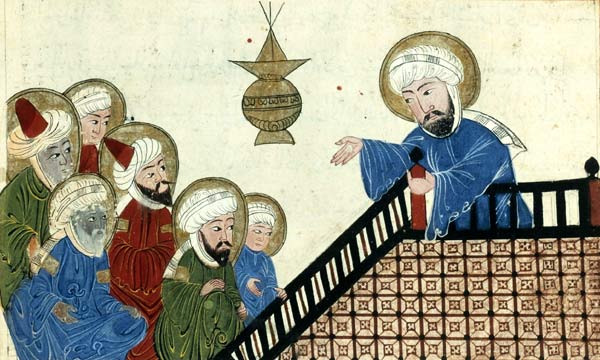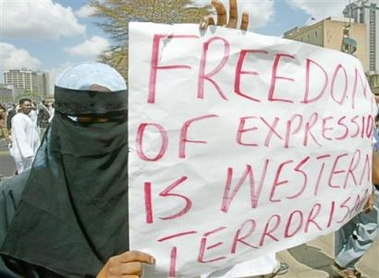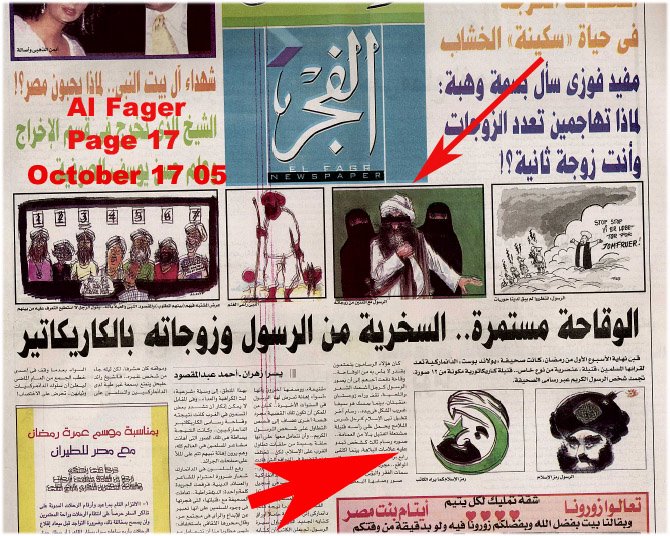
My
original post on this issue has generated more discussion than any other entry that I've posted here, but my
follow-up post has -- so far -- received only a single comment.
This comment was posted by a Muslim who goes by the name "
Muslim" and who has his own blog,
Beconvinced. Muslim is not an especially active blogger, for he posted his most recent entry about a year ago, on April 01, 2005. From quickly scanning his posts, I see that most if not all consist of reprints from various online documents that proselytize for Islam.
Not -- as
Seinfeld would say -- that there's anything wrong with that.
Moreover, Muslim's borrowed postings are respectful in tone, as is his
own comment on my blog:
Muslim said...
What was the point of making these pictures of our beloved prophet Muhammad peace be upon him?
In Islam we dont make pictures of any other prophets. We respect all prophets, Jesus, Moses, Abraham. In our religion, even if you made pictures of these prophets, it would be considered a big sin.
We respect all religions, yet why dont the people who drawed what they did respect ours?
Moreover, why not write about our prophet peace be upon him from true sources? if you really learn about this Prophet, you will see what a mercy he was to mankind.
Thank you for your post, Muslim. Let me respond to your points.
What was the point of the images? From my reading of the news, the point was to test the freedom of illustrators to draw images of Muhammad. A Danish author named Kare Bluitgen had written a respectful book about Muhammad for children but could find no artist willing to do the illustrations for fear of the Muslim reaction. Their fear came in the wake of
Theo Van Gogh's murder in broad daylight upon a crowded street in Amsterdam by the radical Islamist
Mohammed Bouyeri. Van Gogh's offense had been his movie
Submission, made with lapsed Muslim
Ayaan Hirsi Ali, which had criticized the condition of women under Islam and had shocked Muslims by showing the image of a partially naked woman with Qur'anic verses written upon her body. The
Jyllands-Posten newspaper, having heard of Bluitgen's difficulty in finding an illustrator and wishing to defend the hard-achieved right of free expression, decided to hold a contest for the best satirical images of Muhammad. Personally, I would not have favored such a competition for
satirical images. The same point could have been made more respectfully with nonsatirical illustrations. However, I do support their right to free expression, and that includes the freedom to print the satirical images.
You state that under Islam, Muslims do not make images of Muhammad. Strictly speaking, this is not correct. Many, many such images exist. I posted
one of them on my original blog entry and linked to several more (such as the one above from a Persian or central Asian illustration showing Mohammed (on the right) preaching, borrowed from
here). Apparently, there does exist
a hadith found in Volume 7, Book 62, Nr. 110 of
Sahih Bukhari that describes Muhammad condemning depictions of living things, but I wonder if its
isnad (chain of transmission) is strong, for Muslims do have images of living things, even images of the Prophet himself. If you -- or somebody -- could explain this to me, I'd appreciate it.
You say that Islam respects all religions. Does it? I don't have the impression that it respects polytheistic religions. Nor do I have the impression that Islam
truly respects other monotheistic religions. Jews and Christians are allowed to practice their religions in Muslim lands (except for Saudi Arabia), but does the second-class status of Judaism and Christianity really suggest respect? According to Shariah, the word of a Jew or a Christian has no legal validity against the word of a Muslim. That doesn't seem to confer much respect. Also, I read translations of sermons by imams provided by
MEMRI (Middle East Media Research Institute), and from what I've read, I find not merely a lack of respect but an open hatred of Jews and Christians.
Finally, on your point that Muhammad was "a mercy ... to mankind," I find it hard to agree. Narrowly conceived, I grant that
if Allah really expects of people what the
Qur'an and the hadith claim, then Muhammad is a "mercy" for showing the right path, for without that path, there would be only damnation. But I don't see why I should accept the if-clause. Moreover, I
have read enough of the life of Muhammad to persuade me that "merciful" is not the adjective to choose for describing many of his actions.
Still, I thank you for your comment, which I found respectful, and I hope that my response has been equally respectful even though we do not agree.



























